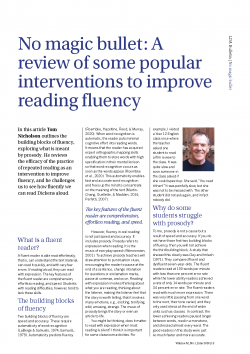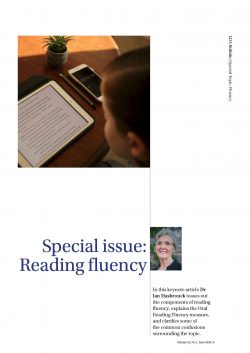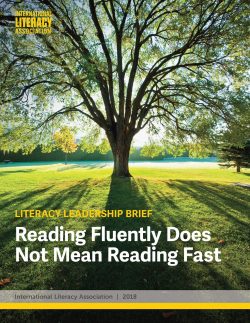Reading fluency encompasses the speed or rate of reading, as well as the ability to read materials with expression. Meyer and Felton defined fluency as “‘the ability to read connected text rapidly, smoothly, effortlessly, and automatically with little conscious attention to the mechanics of reading, such as decoding” (1999, p. 284). Children are successful with decoding when the process used to identify words is fast and nearly effortless or automatic.
Useful Links
Fluency interventions for elementary students with reading difficulties: a synthesis of research from 2000–2019
Oral reading fluency (ORF) deficits are a hallmark of reading difficulties. The impact of fluency struggles extends beyond word-level…
Oral reading fluency (ORF) deficits are a hallmark of reading difficulties. The impact of fluency struggles extends beyond word-level difficulties to include deficits in reading comprehension. Sixteen empirical studies conducted in 2000-2019 that examined ORF interventions among elementary students…
Oral reading fluency (ORF) deficits are a hallmark of reading difficulties. The impact of fluency struggles extends beyond word-level difficulties to include deficits in reading comprehension. Sixteen empirical studies conducted in 2000-2019 that examined ORF interventions among elementary students identified as having reading difficulties were reviewed to identify the characteristics (e.g., instructional variables, group size, type of interventionist) of effective ORF interventions and their impact on English oral reading fluency and reading comprehension outcomes. The systematic review revealed that interventions reported centered around repeated reading procedures (86.5%). Across the 16 studies, outcomes for oral reading fluency varied widely and most focused on speed and rate aspects rather than prosody. Effect sizes for rate and accuracy measures ranged from negligible to large (i.e., 0.01 to 1.18) and three studies found large effects for prosody outcomes. Effect sizes for reading comprehension ranged between non-significant and large significant effects. Findings support the use of repeated reading of text to build up ORF of students with reading difficulties. Interventions that were found to be most effective were those that were conducted one-on-one with a trained model of fluent word reading and accuracy. Findings also point to three gaps in our understanding:
(1) the efficacy of interventions other than repeated reading,
(2) effects of ORF interventions on prosody outcomes, and
(3) sustainability of outcomes.

No magic bullet: A review of some popular interventions to improve reading fluency
In this article Tom Nicholson outlines the building blocks of fluency, exploring what is meant by prosody. He reviews…
In this article Tom Nicholson outlines the building blocks of fluency, exploring what is meant by prosody. He reviews the efficacy of the practice of repeated reading as an intervention to improve fluency, and he challenges us to see…
In this article Tom Nicholson outlines the building blocks of fluency, exploring what is meant by prosody. He reviews the efficacy of the practice of repeated reading as an intervention to improve fluency, and he challenges us to see how fluently we can read Dickens aloud.

Understanding reading fluency
In this keynote article Dr Jan Hasbrouck teases out the components of reading fluency, explains the Oral Reading Fluency…
In this keynote article Dr Jan Hasbrouck teases out the components of reading fluency, explains the Oral Reading Fluency measure, and clarifies some of the common confusions surrounding the topic.
In this keynote article Dr Jan Hasbrouck teases out the components of reading fluency, explains the Oral Reading Fluency measure, and clarifies some of the common confusions surrounding the topic.
The Effects of Reading Fluency Interventions on the Reading Fluency and Reading Comprehension Performance of Elementary Students With Learning Disabilities: A Synthesis of the Research from 2001 to 2014
Fluent word reading is hypothesized to facilitate reading comprehension by improving automatic word reading, thus releasing a reader’s cognitive…
Fluent word reading is hypothesized to facilitate reading comprehension by improving automatic word reading, thus releasing a reader’s cognitive resources to focus on meaning. Many students with learning disabilities (LD) struggle to develop reading fluency, which affects reading comprehension….
Fluent word reading is hypothesized to facilitate reading comprehension by improving automatic word reading, thus releasing a reader’s cognitive resources to focus on meaning. Many students with learning disabilities (LD) struggle to develop reading fluency, which affects reading comprehension. This synthesis extends Chard, Vaughn, and Tyler’s (2002) review, synthesizing fluency intervention research from 2001 to 2014. The search yielded 19 studies examining reading fluency and comprehension outcomes of reading fluency interventions for students with LD in kindergarten through 5th grade. Results showed repeated reading (RR), multicomponent interventions, and assisted reading with audiobooks produced gains in reading fluency and comprehension. Providing a model of fluent reading and performance feedback, using easier level text, setting a performance criterion, and practicing RR with peers also contributed to improved outcomes. Findings suggest that RR remains the most effective intervention for improving reading fluency for students with LD. Limitations include sample size, only three group design studies, and infrequent use of standardized measures.

